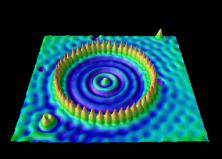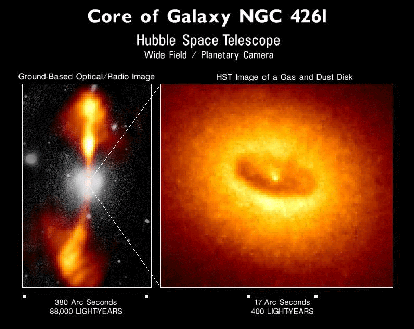|
The picture on
the left is a "corral" of iron atoms, arranged in a circle by hand
(actually using a scanning tunnelling electron microscope. The corral is
around one billionth of a meter across. The circular ripples inside the
corral are electron waves, which show that at the microscopic levels,
particles such as electrons are not localised. This picture, in addition to
being a technological marvel, is striking verification of the bizarre
predictions of quantum mechanics, the theory known to accurately describe the
world of atoms and electrons. The picture on the right was taken by the
Hubble space telescope. It shows the accretion disk of a monstrous back hole
at the core of a galaxy many light years away. This picture too is a
technological marvel, taken by a telescope in orbit around the Earth, and
provides beautiful support for the existence of black holes, which are among
the more bizarre predictions of Einstein's theory of gravity, or general
relativity as it is known by scientists. General relativiy is known to
accurately describe the dynamics of very massive, large gravitating objects.
It is an amazing circumstance that the two physical theories graphically
represented on this slide are in fact not compatible with each other. If one
applies the rules of quantum mechanics to Einstein's theory, one gets
puzzling contradictions, an indication that one or both theories must be
substantially revised before they can co-exist. The search for a consistent
theory of "quantum gravity" unifying the laws of the very small
with those of the very large, is currently one of the most important tasks
confronting modern physics. The purpose of this talk is to give an overview
of Einstein's gravity and black holes, and then to show how black holes are
playing such a vital role in this quest for a unified theory of quantum
mechanics and gravity. The outline of the talk is given on the next slide.
|







